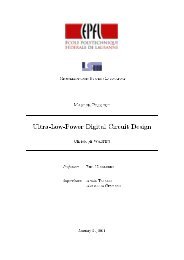Compressive Sensing system for recording of ECoG signals in-vivo
Compressive Sensing system for recording of ECoG signals in-vivo
Compressive Sensing system for recording of ECoG signals in-vivo
Create successful ePaper yourself
Turn your PDF publications into a flip-book with our unique Google optimized e-Paper software.
4.1.3. Serial Implementation with two PRBSIn [3] the measurement matrix generation has been carried out by us<strong>in</strong>g the comb<strong>in</strong>ation <strong>of</strong>PRBS generators, one <strong>of</strong> them with 50 Flip-Flops and the other one with 15 Flip-Flops. As it canbe observed <strong>in</strong> Fig.4.1.3.1, the top block generates 50 different outputs, each <strong>of</strong> them com<strong>in</strong>gput from a Flip-Flop.The bottom block is settled as one output serial PRBS with randomness period <strong>of</strong> 2 15 – 1. Inorder to achieve 50 outputs <strong>in</strong> each clock cycle by keep<strong>in</strong>g uncorrelated each <strong>of</strong> the 50 bitssequences,the bottom PRBS mixes each <strong>of</strong> the outputs from the top PRBS by XOR<strong>in</strong>g itscurrent output value by all their outputs. In this way, it is possible to accomplish 2 15 – 1 randomsequences which ma<strong>in</strong>ta<strong>in</strong> no correlation between each others.Figure 4.1.3.1.Random Generator [3].By keep<strong>in</strong>g this idea <strong>in</strong> m<strong>in</strong>d [3], a new random matrix generator based on two PRBS has beenachieved <strong>in</strong> order to generate multiple sequences outputs. As it is depicted above, this design ismuch compact than the parallel one, and simultaneous outputs are achieved by cleverlycross<strong>in</strong>g the states <strong>of</strong> the two PRBSs by XOR<strong>in</strong>g them. A sketch <strong>of</strong> how is executed theoperation is <strong>in</strong>cluded <strong>in</strong> Fig. 4.1.3.2. In this case, a 4FF-PRBS and a 5FF-PRBS have beencomb<strong>in</strong>ed <strong>in</strong> order to achieve 16 parallel outputs [31].For the case <strong>of</strong> a 16 outputs serial Implementation with two PRBS, the crosses have beenconsidered are shown <strong>in</strong> Appendix D. Each PRBS is created by an LFSR, so the ‘0’ or ‘1’ valuescirculate sequentially from a FF to the next one without chang<strong>in</strong>g till a tap is reached. In order toavoid the same state to propagate <strong>in</strong> successive clock periods, crosses have been chosen <strong>in</strong>order to obta<strong>in</strong> 16 outputs follow the follow<strong>in</strong>g criteria: a) the first FF <strong>of</strong> 4FF-PRBS is XORedwith the four last FFs <strong>of</strong> 5FF-PRBS, (four outputs are achieved); b) the last FF <strong>of</strong> 4FF-PRBS isXORed with the four last FFs <strong>of</strong> 5FF-PRBS, (four outputs are achieved); c) The first FF <strong>of</strong> 5F-PRBS is XORed with the four first FFs <strong>of</strong> the 4FF-PRBS, (four outputs are achieved); d) look <strong>for</strong>four more outputs by tak<strong>in</strong>g <strong>in</strong>to consideration outputs which have not been previously mixed43















